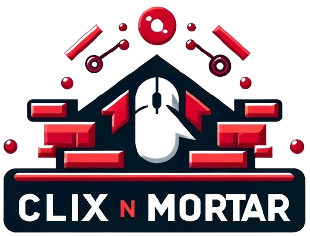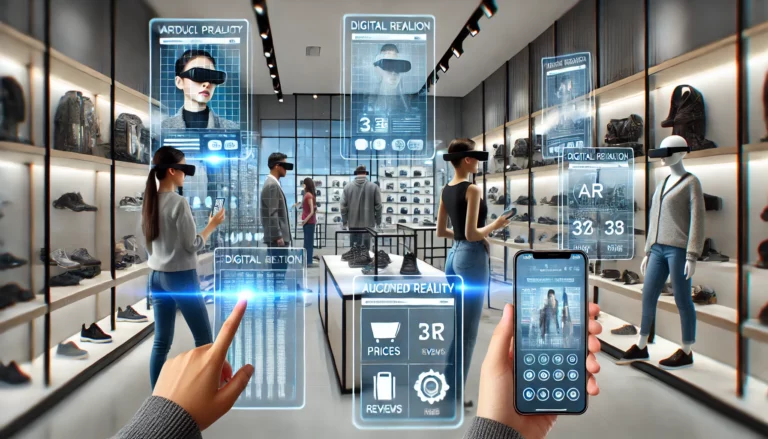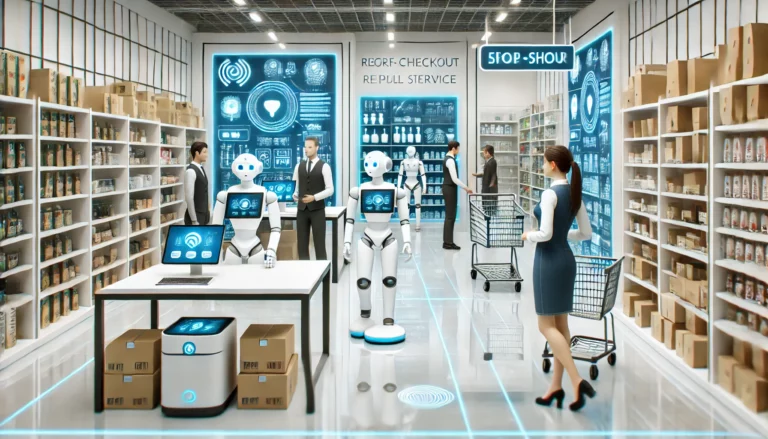How to Integrate IoT in Retail
Table Of Contents
How to Integrate IoT in Retail for Enhanced Customer Experience and Efficiency
Key Takeaways
- Comprehending the Internet of Things in the retail sector
- Advantages of incorporating Internet of Things in retail
- Procedures for incorporating Internet of Things in retail
- Innovations propelling retail Internet of Things
- Obstacles in executing Internet of Things in retail
- Prospects for the future of the retail Internet of Things market
Understanding IoT in Retail
The internet of things (IoT) has revolutionized the landscape of retailing, offering retail businesses innovative ways to enhance operations and customer engagement. IoT devices, ranging from smart shelves to connected payment systems, enable retailers to collect and analyze data in real time, creating a seamless shopping experience across both online stores and brick-and-mortar retail shops. Understanding how to integrate IoT in retail involves recognizing the potential of e-commerce platforms to leverage this technology effectively. Retail companies can utilize IoT to streamline logistics, optimize inventory management, and tailor marketing strategies, making it an essential component of modern retail business strategies. By adopting these technologies, retailers position themselves to meet the evolving demands of consumers in a highly competitive market.
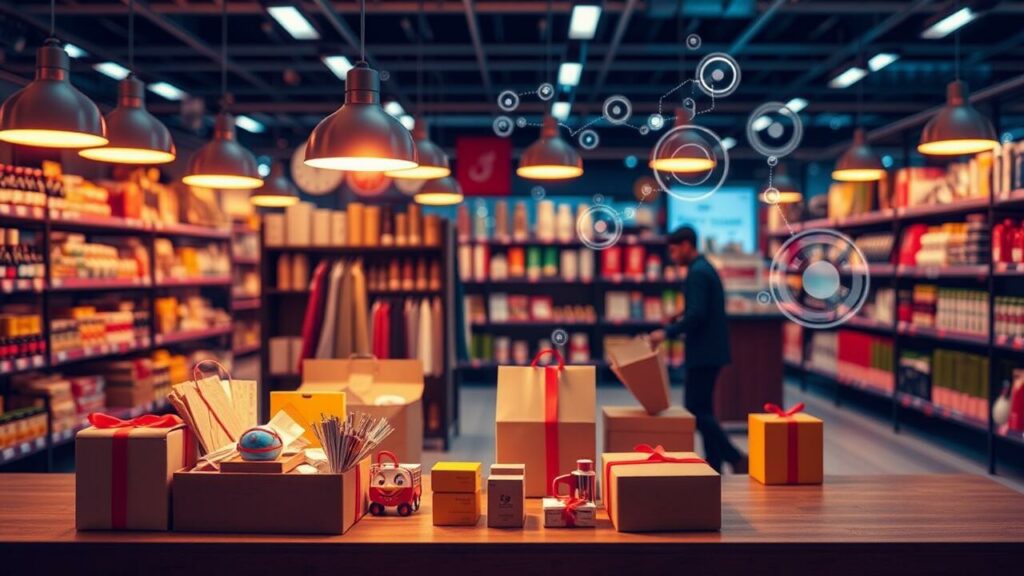
Definition and Key Concepts
The internet of things (IoT) refers to a network of interconnected devices that communicate and exchange data through the internet. In the retail industry, these technologies enable retailers to enhance their operations and customer interactions. From smart shelves in retail stores to RFID tags that monitor inventory levels, the integration of IoT is revolutionizing the retail market. Retailers, including those in e-commerce platforms like Shopify, are increasingly leveraging IoT to streamline processes and improve service delivery.
Understanding how to integrate IoT in retail involves recognizing the key concepts and technologies that underpin this transformation. Sensors, cameras, and other IoT devices collect valuable data that can be analyzed to understand customer behavior in convenience stores and large retail chains. By harnessing the power of the internet-of-things, retailers can provide tailored experiences and optimize their supply chain management, leading to a more efficient and responsive retail environment.
Current Trends in Retail IoT
Retailers are increasingly adopting RFID technology to enhance inventory accuracy and streamline their operations. This innovation not only minimizes human error but also accelerates the process of tracking items in warehouses. Automation plays a crucial role in how to integrate IoT in retail, enabling retailers to optimize their supply chains. Online shopping trends have accelerated the need for efficient inventory management, pushing retailers to explore advanced solutions that leverage the internet for real-time data and insights.
Emerging network infrastructure solutions are transforming the way retailers engage with customers. By implementing sophisticated firmware updates and IoT devices, retailers can gather valuable data to improve the customer experience and personalize offerings. Warehouse automation is becoming more prevalent, allowing retailers to manage stock levels seamlessly while responding to changes in purchasing behavior. As the market evolves, understanding how to integrate IoT in retail becomes essential for staying competitive in an increasingly digital landscape.
Benefits of Integrating IoT in Retail
Integrating IoT in retail offers significant advantages that can transform both online and brick-and-mortar stores. Smart devices equipped with sensors and wireless technology streamline process automation, leading to enhanced digital asset management and efficient inventory tracking. Investments in robust infrastructures allow retailers to implement firmwares that optimize the supply chain, ensuring merchandise is available when needed. For flagship stores and department stores, this technology can revolutionize the customer experience by providing tailored interactions and real-time data insights. Understanding how to integrate IoT in retail not only boosts operational efficiency but also positions businesses for future growth in an increasingly competitive landscape.
Enhanced Customer Experience
The integration of IoT in retail leverages learning technologies to create personalized shopping experiences for customers. Retail IoT solutions utilize data from various sources, enhancing engagement through tailored recommendations and targeted promotions. By analyzing customer behavior in real-time, businesses can optimize their offerings and improve satisfaction levels. Understanding how to integrate IoT in retail helps brands take advantage of these innovations, ultimately leading to increased loyalty and sales.
IoT technology enables retailers to streamline operations while enhancing customer interactions. With robust network infrastructures in place, IoT applications can connect devices, simplifying inventory management and checkout experiences. Retail IoT works by utilizing IoT-based technologies to collect and analyze data, leading to smarter decision-making. As the retail IoT market expands, businesses are making significant IoT investments to stay competitive and meet evolving customer expectations.
Improved Inventory Management
IoT-based solutions are revolutionizing inventory management in retail by enhancing visibility and efficiency. Companies can implement IoT-enabled warehouse automation systems that provide real-time tracking of products. Achieving this requires an effective IoT strategy that combines new IoT technologies with existing infrastructure. Organizations must assess their own IoT systems to ensure seamless integration with traditional inventory management processes. By leveraging IoT applications, retailers can increase accuracy and responsiveness to customer demands.
Integrating IoT technology offers significant advantages over traditional methods. Retailers can use IoT networks to gather data that informs smarter purchasing decisions and reduces stockouts. The deployment of IoT expertise helps streamline operations, resulting in more efficient processes and cost savings. As businesses explore how to integrate IoT in retail, understanding the benefits of IoT implementation is crucial for optimizing performance and maximizing inventory turnover. Retail automation through IoT not only enhances operational efficiency but also contributes to an improved overall customer experience.
- Improved real-time tracking of inventory, leading to enhanced decision-making.
- Decreased likelihood of stockouts through proactive inventory management.
- Streamlined communication across supply chain partners for quicker responses.
- Enhanced forecasting capabilities using data analytics from IoT devices.
- Reduction in manual errors and discrepancies in inventory records.
- Greater visibility into inventory levels, aiding in better resource allocation.
- Improved customer satisfaction with timely product availability and management.
Steps for How to Integrate IoT in Retail
To effectively explore how to integrate IoT in retail, businesses should start by assessing their specific needs and identifying potential iot-enabled devices that can enhance operations. Collaborating with iot developers and IoT software developers who specialize in retail analytics can provide valuable insights into the most interesting IoT use cases. Establishing an efficient IoT network is crucial for seamless data transfer and processing, allowing for real-time decision-making. Companies can benefit significantly from engaging IoT development services to implement customized IoT solutions that align with their goals. As retail continues to evolve, leveraging IoT data and enlisting the expertise of IoT experts can accelerate IoT adoption and the successful deployment of IoT-enabled robots, ultimately driving efficiency and customer satisfaction.
| Step | Description | Key Benefits |
|---|---|---|
| Assess Needs | Identify specific operational needs and areas for IoT enhancement. | Helps tailor IoT solutions to fit unique business requirements. |
| Collaborate with Experts | Work with IoT developers and analytics specialists. | Gains insights into effective IoT use cases and strategies. |
| Establish IoT Network | Set up an infrastructure for seamless data transfer and processing. | Enables real-time decision-making and operational efficiency. |
| Implement Customized Solutions | Engage IoT development services for tailored applications. | Aligns IoT deployment with business goals for optimal performance. |
| Leverage IoT Data | Utilize data insights for informed marketing and operational strategies. | Enhances customer satisfaction and operational efficiency. |
Assessing Business Needs
Understanding how to integrate IoT in retail is essential for any business looking to enhance operations. Retail environments today benefit from the application of IoT sensors and IoT-enabled sensors that provide real-time data. By assessing specific business needs, retailers can determine how to best leverage IoT connectivity to achieve their goals. Companies like Walmart’s IoT efforts serve as prime examples of how an effective IoT rollout can lead to significant improvements in operational efficiency and customer experience.
Identifying the right IoT vision requires evaluating existing processes and pinpointing areas that could benefit from sophisticated IoT functionalities. Retailing industry leaders should focus on developing strategies that facilitate successful IoT results. Companies like Simon IoT highlight the importance of aligning IoT initiatives with overall business objectives. Engaging in thorough assessments allows businesses to tailor their IoT solutions to meet unique challenges in the retail sector while paving the way for future growth.
Selecting the Right IoT Devices
Choosing the appropriate IoT devices is crucial for enhancing retail operations. Retail chains must assess their current digital infrastructure and identify specific needs before purchasing. Technology buyers should focus on devices that align with their business goals and can seamlessly integrate with existing systems. For instance, a Shopify store might benefit from smart shelves equipped with sensors to monitor inventory levels. This approach facilitates real-time tracking and improves store management, allowing businesses to deliver a superior customer experience at every retail spot.
Retail software development plays a significant role in determining the right devices for integration. Businesses can leverage advanced sensors and analytics tools to streamline processes and enhance efficiency. Incorporating IoT devices helps retailers respond quickly to customer demands and shifts in market trends. Understanding how to integrate IoT in retail requires evaluating various options, ensuring that selected devices enhance operational capabilities while supporting ongoing digital innovation. Proper device selection can empower retailers to optimize their strategy while navigating the complexities of an evolving market.
Technologies Driving Retail IoT
The integration of advanced technologies is crucial for retail success in the IoT landscape. Sensors and RFID inventory management improve stock accuracy, allowing shops to maintain optimal store setups that enhance customer satisfaction. Cloud computing and big data analytics integration provide retailers with insights that enable accurate purchase recommendations, helping them understand consumer behavior. The advent of 5G-based internet facilitates real-time data transfer, promoting supply chain transparency that empowers businesses to streamline operations. As retailers learn how to integrate IoT in retail effectively, they can leverage these technologies to transform both physical shops and their online platforms, positioning themselves as powerful ecommerce companies in a competitive market.
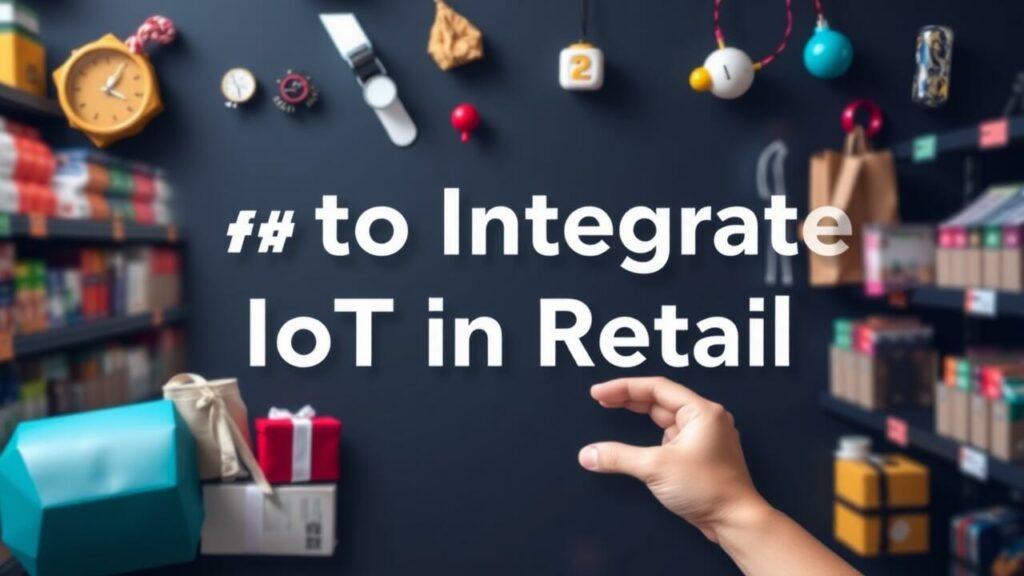
Sensors and RFID
The integration of sensors and RFID technology in retail is pivotal in enhancing operational efficiency. These technological components allow retailers to keep track of inventory levels in real-time. Store managers can utilize this data to maintain optimized inventory, ensuring that popular items are always available while reducing excess stock. This capability answers the pressing business needs of many retailers and sets a foundation for innovative practices such as mobile shopping apps. Understanding how to integrate IoT in retail can significantly benefit global retailers, helping them adapt to the growing demands of the market.
The impact of sensors and RFID extends to transforming customer experiences in stores. With these tools, retailers can provide personalized services that cater to individual preferences by collecting and analyzing data from various touchpoints. As the global internet continues to connect consumers and businesses alike, the retail sector offers unparalleled opportunities for those willing to embrace this new technology. Implementing these advancements enables retailers to anticipate customer needs and streamline operations effectively. Insights gained through RFID and sensors empower retailers on how to integrate IoT in retail, ensuring they remain competitive in a rapidly evolving landscape.
Cloud Computing and Big Data
The integration of cloud computing and big data into retail significantly enhances how businesses utilize internet-connected devices. With smart shelves and digital systems linked to a centralized digital platform, retailers can track inventory in real-time, making it easier to optimize store layouts and improve business efficiency. These technologies provide reliable analytics that aid in decision-making, helping small businesses as well as large store chains to fine-tune their operations. Understanding how to integrate IoT in retail means tapping into the potential of these advanced data solutions to create a streamlined buying experience for customers.
Implementing cloud solutions and harnessing big data helps establish seamless payment processes, thus enhancing customer satisfaction. By leveraging technology associations that focus on IoT in retail, companies can easily align their operations with modern consumer expectations. This capability not only increases sales opportunities but also drives operational insights that lead to improved service delivery. Retailers looking to innovate must recognize the importance of integrating these technologies into their strategy for effectively navigating today’s competitive landscape.
Challenges in Retail IoT Implementation
Implementing IoT in retail presents various challenges that companies must navigate. Major retailers are often concerned about data security, as sensitive information collected through platforms could be vulnerable to breaches, posing risks not only to their operations but also to customer trust. Businesses must also address interoperability issues among different tech systems, which can hinder the seamless use of warehouse sensors and automated systems. As department store chains venture into sophisticated data management for better marketing analytics, they may face hurdles integrating process optimization technologies effectively. Shop owners need to understand how to integrate IoT in retail to mitigate risks associated with retail crime and ensure that their investments in technology enhance overall efficiency and customer experience.
Data Security Concerns
As retailers increasingly utilize IoT technologies to enhance the shopping experience, concerns regarding data security become paramount. Solutions like in-store robots and indoor navigation tools assist in navigating customers and ensuring accurate delivery tracking. However, the integration of cash register systems and advanced data analytics raises challenges. Safeguarding sensitive customer information while meeting business demand for improved process automation is critical for maintaining consumer trust.
Implementing robust security measures is essential for protecting data throughout the integration of IoT devices. Retailers must consider how to integrate IoT in retail without compromising security protocols. Failure to secure data could lead to unauthorized access and potentially harmful breaches. By addressing these concerns early in the setup process, retailers can create a safer environment for in-store shoppers while ensuring the effective use of technology.
Interoperability Issues
Integration in retail IoT can present significant challenges due to interoperability issues. Different devices and systems must communicate seamlessly for improved warehouse efficiency and product visibility. Many organizations struggle with how to integrate IoT in retail as they manage various technologies and platforms. An effective integration strategy should include regular updates for device firmwares to ensure compatibility. Without this essential step, businesses may face disruptions in their everyday operations, hindering the potential benefits of automation that enhances personalized shopping experiences for shoppers.
Technological trends continue to evolve rapidly in the retail sector. SmartTek solutions are at the forefront of this evolution, but achieving seamless integration remains a critical hurdle. Retailers must develop robust warehouse management systems that can accommodate various protocols and standards. Failure to do so may limit the effectiveness of IoT implementations, ultimately affecting customer satisfaction. Organizations seeking to navigate these interop challenges must prioritize a unified approach to connectivity, allowing them to fully leverage their IoT capabilities and improve overall operational efficacy.
| Interoperability Challenge | Impact | Potential Solution |
|---|---|---|
| Device Compatibility | Disruptions in communication between devices | Regular firmware updates and standardized protocols |
| Diverse Technologies | Increased complexity in system integration | Developing a unified API for all devices |
| Lack of Standardization | Inconsistent data sharing and reporting | Adopting industry-wide best practices and standards |
| Limited Scalability | Difficulty in expanding IoT solutions | Implementing flexible systems capable of scaling as needed |
Future Outlook of the Retail IoT Market
The retail IoT market is poised for significant growth, driven by the need for businesses to enhance operational efficiency and customer satisfaction. A prominent application of IoT includes the integration of advanced inventory tracking systems that allow retailers to connect devices seamlessly. For instance, a fitness goods retailer can utilize warehouse robots powered by AI-enabled systems to automate restocking and improve purchase processes. As retailers explore how to integrate IoT in retail effectively, the focus on increased integration across platforms becomes essential. The trend towards smart stores equipped with IoT technologies presents a convenient option for both consumers and business owners, ensuring a transformative impact on the retail landscape.
- Increased adoption of AI and machine learning to enhance customer experience.
- Growth of smart shelves and automated checkout systems for improved efficiency.
- Expansion of data analytics for better inventory management and demand forecasting.
- Rising investments in cybersecurity to protect IoT devices and customer data.
- Expanded use of beacons and location-based services to personalize shopping experiences.
- Collaboration between retailers and tech companies to innovate IoT solutions.
- Focus on sustainability through IoT applications that reduce waste and energy consumption.
Conclusion
The integration of IoT in retail offers significant opportunities for transforming the industry landscape. Understanding how to integrate IoT in retail involves assessing business needs and selecting the right devices to enhance point-of-sale systems and other additional applications. These connected devices create a robust network that seamlessly connects shoppers to tailored experiences, driving customer satisfaction and loyalty. As businesses navigate the implementation of these technologies, they can leverage the potential of IoT to streamline operations and deliver innovative solutions, ensuring they remain competitive in an ever-evolving market.
FAQS
How can retail businesses optimize their supply chain using the Internet of Things (IoT) and what role do traditional IoT implementations play in this process?
Retail businesses can leverage the Internet of Things (IoT) to achieve supply chain optimization by implementing various IoT solutions that enhance supply-chain transparency and empower shop owners. For instance, Walmart’s IoT efforts showcase how a powerful ecommerce company can utilize network technologies to assist in navigating customer preferences and ensuring that the right merchandise is available at the right time. Furthermore, an effective business strategy might include automation to reduce daily operational burdens, as well as regular updates of device firmwares to maintain optimal functionality. By integrating IoT into their operations, retail shops can enhance everyday business efficiency while effectively managing their supply chain.
How can a retail shop’s owner utilize traditional IoT to assist in navigating customers and ensuring supply chain transparency empowers their business?
Retail shops can leverage the internet-of-things (IoT) by using traditional IoT implementations that network help businesses streamline processes, such as tracking merchandise right through the supply chain. For instance, Walmart’s IoT efforts illustrate how automation reduces manual tasks and enables quick updates to device firmwares, thereby enhancing operational efficiency. Additionally, utilizing IoT portals can assist shop owners in understanding customer behavior, which further supports an effective merchandising strategy.
How can a retail shop’s owner leverage IoT technology to enhance supply-chain transparency and assist in navigating customers, particularly in light of Walmart’s IoT efforts?
Retail shop’s owners can leverage IoT technology to enhance supply-chain transparency by employing smart inventory systems and tracking devices that provide real-time updates on stock levels. Such tools can assist in navigating customers by offering a more streamlined shopping experience. Additionally, integrating systems that can update device firmwares will ensure that the IoT devices operate effectively, allowing the retail shop’s owner to be more responsive to changes in customer demand and inventory status, thereby ensuring that retail efforts come together to optimize operations.
How can the integration of IoT technologies in retail assist a shop’s owner in enhancing supply-chain transparency while navigating customers, particularly considering Walmart’s IoT efforts?
The integration of IoT technologies in retail can significantly assist a shop’s owner by improving supply-chain transparency and facilitating better navigation for customers. IoT can provide real-time data on inventory levels and customer behaviors, allowing a retail shop’s owner to optimize operations and make informed decisions. Moreover, insights gathered from IoT systems can help retail include features that address customer needs effectively. Walmart’s IoT efforts serve as a benchmark, illustrating how improved supply-chain transparency empowers businesses to thrive in a competitive market.
How can a retail shop’s owner effectively implement IoT solutions to improve customer navigation and increase transparency in the supply chain, especially in the context of Walmart’s IoT efforts?
A retail shop’s owner can effectively implement IoTs to assist in navigating customers by utilizing smart signage and location-based services that guide customers through the store. These technologies can enhance customer experience while also providing insights into shopping patterns. Additionally, integrating IoT in retail enables the shop’s owner to achieve greater supply-chain transparency by tracking inventory in real-time, which aligns with Walmart’s IoT efforts to optimize logistics and streamline operations. This dual approach not only improves service but also empowers the shop’s owner to manage resources more efficiently.
What strategies can a shop’s owner adopt to incorporate IoT solutions in their retail environment and effectively assist in navigating customers, especially when considering walmart’s IoT efforts?
A shop’s owner can implement several strategies to utilize IoT solutions in their retail environment effectively. These strategies may include deploying smart shelf technology, using beacons for personalized customer navigation, and integrating inventory management systems that provide real-time data. By adopting these IoT advancements, the shop’s owner will be able to enhance customer experiences and streamline operations, ultimately assisting in navigating customers more effectively while also aligning with walmart’s IoT efforts.
How can a shop’s owner effectively utilize IoT solutions to assist in navigating customers within the retail environment while also considering Walmart’s IoT efforts?
A shop’s owner can effectively utilize IoT solutions to assist in navigating customers by implementing smart signage, mobile apps that guide customers through the store, and real-time inventory management systems. These strategies not only enhance the shopping experience but also align with Walmart’s IoT efforts, demonstrating how modern retail can improve efficiency and customer satisfaction.
What are the benefits for a shop’s owner in utilizing IoT solutions to enhance the retail environment and assist in navigating customers, particularly in the context of Walmart’s IoT efforts?
A shop’s owner can significantly improve the retail environment by utilizing IoT solutions, which not only streamline operations but also enhance customer experience. Methods such as smart signage and customer tracking systems can assist in navigating customers effectively within the store. Additionally, leveraging insights from Walmart’s IoT efforts can guide a shop’s owner in implementing innovative strategies that may lead to increased customer satisfaction and loyalty.
In what ways can a shop’s owner integrate IoT technologies into their retail environment to optimize operations and enhance customer interactions, especially in the context of Walmart’s IoT efforts?
A shop’s owner can integrate IoT technologies in various ways to optimize their operations and enhance customer interactions. By utilizing smart shelves, inventory tracking systems, and customer heat maps, they can gain insights into customer behavior and improve product availability. This approach allows the shop’s owner to streamline operations and effectively assist in navigating customers within the retail environment. Additionally, by analyzing data from IoT devices, the owner can make informed decisions on restocking and promotions, ultimately contributing to a more efficient retail experience and aligning with Walmart’s IoT efforts.
How does incorporating IoT solutions in retail environments assist a shop’s owner in navigating customers effectively and optimizing their business operations, particularly in light of Walmart’s IoT efforts?
Incorporating IoT solutions in retail environments significantly assists a shop’s owner by streamlining operations and enhancing customer experience. Through real-time data analytics, shop’s owners can better understand customer preferences and behaviors. This insight allows for improved navigation within retail spaces, helping customers find products more efficiently. Furthermore, with the rise of Walmart’s IoT efforts, other retailers can learn from their initiatives to integrate similar technologies that not only assist in navigating customers but also optimize inventory management and enhance overall operational transparency in the retail space.
